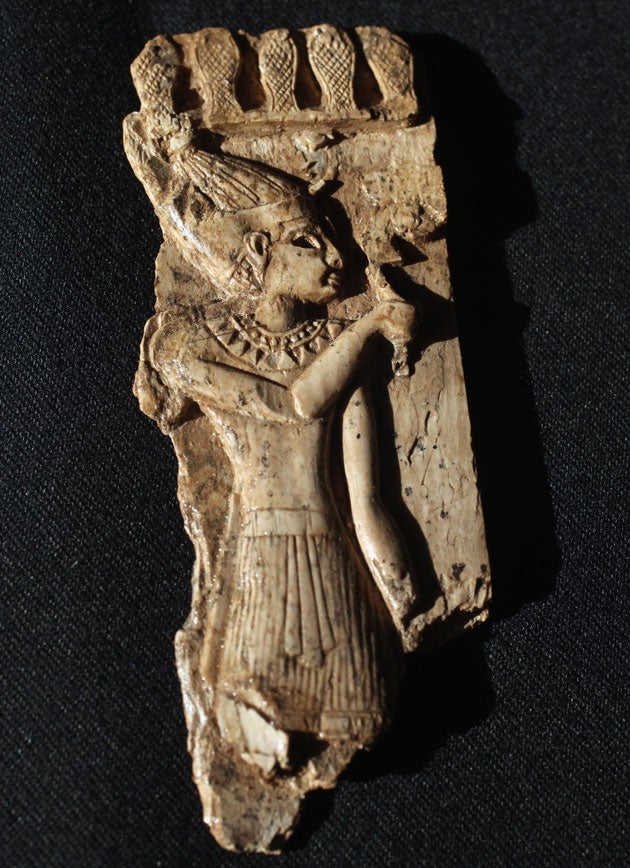It is hard to believe that some of these delicate ivory carvings, excavated from the ancient Assyrian city of Nimrud, are almost 3,000 years old. Yet perhaps more remarkable is the fact their lustre was first restored, at a dusty archaeological site in Iraq, by the novelist Agatha Christie through the patient application of face cream.
The British Museum has paid £1.2m for the Nimrud Ivories, the finest collection of decorative ivories ever excavated in the Middle East. They were discovered by the British School of Archaeology between 1949 and 1963, on a dig led by Sir Max Mallowan, Christie's second husband and head of an excavation team of which his wife was also a member.
Now bound up in the items' extraordinary history is the love story of their discoverers (which began with an unlikely journey on the Orient Express), and the novels they inspired.
"Oh what a beautiful spot it was... The Tigris was just a mile away, and on the great mound of the Acropolis, big stone Assyrian heads poked out of the soil. In one place there was the enormous wing of a great genie," wrote Christie in her autobiography, which was published in 1977, the year after her death.
"I had my own favourite tools... an orange stick, possibly a very fine knitting needle... and a jar of cosmetic face cream... for gently coaxing the dirt out of the crevices without harming the friable ivory," she wrote.
Christie and her husband were digging at the site of Nimrud in northern Iraq, just south of Mosul. It was built by Assyrian king Shalmaneser I in the 13th century BC. Five hundred years later, it was made the capital of the Assyrian Empire, which then covered modern-day Iraq, Lebanon, Syria, Kuwait and Jordan, as well as about half of Saudi Arabia, Egypt and Iran.
The collection comprises almost 1,000 numbered items, as well 5,000 fragments or unnumbered pieces. These carved ivories, dating from the 9th-7th centuries BC, were mostly made in Syrian and Phoenician cities near the Mediterranean coast and were brought to Assyria as loot.
The most significant pieces were found buried in sludge at the bottom of several wells in the city's north-west palace. They had been thrown there at the time of Nimrud's destruction by the Medes and Babylonians in 612BC.
Their life story became entwined with Christie's when, in 1928, after the collapse of her first marriage and a peculiar 11-day disappearance – after which she was found safe at a hotel in Harrogate checked in under a pseudonym – she boarded the Orient Express for the first time.
In Istanbul, the railway's southern terminus, she wrote one of her most celebrated works, Murder on the Orient Express, from her room at the Hotel Pera Palace. She also met and married Sir Max Mallowan, the apprentice archaeologist 15 years her junior. She accompanied him on his digs throughout the Middle East, as his star rose almost to match that of her own. At Nimrud the team slept in tents, although Christie had her own private mud-brick room, labelled "Agatha's House", to allow her to write undisturbed. She also spent much of her time working on and photographing the objects turned up by the dig.
Her experiences in Iraq soon began to influence her novels. In They Came to Baghdad, published in 1951, she wrote of the experiences of an enthusiastic young tourist: "Unexpectedly, she found the life quite enchanting... Helping with camera work. Piecing together and sticking up pottery. Watching the men at work, appreciating the skill and delicacy of the pick men – enjoying the songs and laughter of the little boys who ran to empty their baskets of earth on the dump."
Christie died in 1976, an event most memorably described in the postscript of Sir Max Mallowan's autobiography: peacefully and gently, and leaving him with a feeling of emptiness after 45 years. He died two years later.
The best of the near 6,000 pieces go on display in the British Museum's Middle East section from next week.

Join our commenting forum
Join thought-provoking conversations, follow other Independent readers and see their replies
Comments